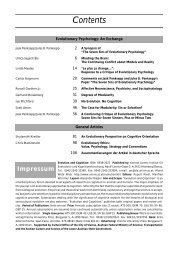Contents - Konrad Lorenz Institute
Contents - Konrad Lorenz Institute
Contents - Konrad Lorenz Institute
You also want an ePaper? Increase the reach of your titles
YUMPU automatically turns print PDFs into web optimized ePapers that Google loves.
Theresa S. S. Schilhab<br />
in that the distinction is operationally unclear (e.g.,<br />
BERRY 1996; FRENSCH 1998). It is clearly impossible<br />
to show that lack of report is due to non conscious<br />
awareness of learning. For one, silence with respect<br />
to the learned material could come about as a result<br />
of the subject’s inclination to withhold information<br />
he/she is not confident of (for discussions on methodological<br />
artifacts in implicit tests see BUCHNER/<br />
WIPPICH 2000) 2 . Moreover self-report is by no means<br />
an exhaustive criterion of consciousness (SCHILHAB<br />
2001). (On discussions of self-report and consciousness,<br />
see also DAVIS 1997; GOLDMAN 2000; VELMANS<br />
1996).<br />
Irrespective of operational considerations, perhaps<br />
it is time to get past the conundrum of consciousness<br />
and ask in what way consciousness predicts<br />
the function of the different learning systems.<br />
Though one cannot argue for one process being superior<br />
to another (RAAB 2003), the question of what<br />
is achieved by using one strategy rather than the<br />
other seems theoretically important (see for instance<br />
TAYLOR 2001, WILSON/SCHOOLER 1991). Specifically,<br />
what assets and drawbacks characterise implicit<br />
versus explicit learning In what respect are<br />
they unique and how they might possibly supplement<br />
each other<br />
To REBER, implicit learning is phylogenetically<br />
more original than explicit learning in the sense,<br />
that the former antedates the latter and is in general<br />
dedicated to ensuring survival. Among other things<br />
he predicted distinctive characteristics of implicit<br />
learning such as robustness of the memory as well as<br />
age and IQ independence.<br />
Here, following the approach recommended by<br />
REBER, I characterise implicit and explicit learning<br />
within a phylogenetic framework and go one step<br />
further to analyse the epistemological qualities<br />
(modes of knowledge) specific to each. To characterise<br />
implicit and explicit learning epistemologically<br />
is to explore which functions they were developed<br />
to fulfil. My primary focus will be on contextual<br />
matters in learning. The paper focuses on the issue<br />
of detachment from reality by using either mode of<br />
learning. Specifically, how explicit learning condenses<br />
reality will be considered. Based on this discussion<br />
I will introduce the notion of vertical and<br />
horizontal learning to capture the specific attributes<br />
of implicit and explicit learning respectively. Vertical<br />
learning (i.e., depth) refers to implicit learning<br />
understood as contextual learning based on relational<br />
aspects, such as the connectivity of available<br />
information in learning situations. Horizontal<br />
learning (i.e., width) refers to explicit learning as<br />
context free, abstract learning. The concept of vertical<br />
and horizontal learning clarifies what separates<br />
implicit and explicit learning as regards evolutionary<br />
adaptation. To qualify claims on the consciousness-based<br />
distinction of implicit and explicit learning<br />
REBER (1992, 1993) recently argued for an<br />
evolutionary stance on the different qualities of the<br />
learning systems.<br />
To Be Explicit is to Be Context-Free<br />
Explicit learning is stored as knowledge that can be<br />
represented deliberately by words or other symbols.<br />
The symbolic character of explicit learning makes it<br />
possible to ‘translate’ knowledge obtained in one<br />
‘language’ into different vocabularies by being context<br />
free (DEACON 1998).<br />
To exemplify; we can talk of the capital of France<br />
as Paris, as a red mark on a map, as a fixed letter<br />
string, as the location which accommodates the<br />
Eiffel Tower and the Triumphal Arc or as the city in<br />
which the final stage of the Tour de France ends<br />
(among other designations). All of these designations<br />
have Paris as their referent. Though Paris is determined<br />
differently from one conception to the<br />
other, by disregarding the information specific to<br />
any particular interpretation, one finds the referent<br />
‘Paris’ to be intrinsic to all. 3<br />
Hence ‘Paris’ is implied in all of the above-mentioned<br />
descriptions, and can replace any of them<br />
without changing the meaning of the sentence.<br />
This transparency entails that we are equally capable<br />
of treating the notion in the language of geography<br />
as in the language of professional bike racing.<br />
Thus, the symbolic nature of explicit knowledge<br />
shows extensive manipulability by being detached<br />
from context.<br />
Two Senses of<br />
‘Detachment from Context’<br />
What is meant by detachment from context Taken<br />
at face value, the assertion is false. Paris is always defined<br />
as part of a greater whole, (the bicycle race,<br />
capital of France, scene of the French Revolution<br />
etc.) though the symbolic representation appears to<br />
grasp the essence of Paris. When dealing with different<br />
understandings of Paris we choose perspective.<br />
Initially, as we came to know of Paris some elements<br />
(variables) or contingencies seemed relevant to our<br />
particular idea of Paris, while others were concurrently<br />
discounted as irrelevant. For instance if interested<br />
in bicycling, watching the Tour de France<br />
Evolution and Cognition ❘ 172 ❘ 2003, Vol. 9, No. 2








